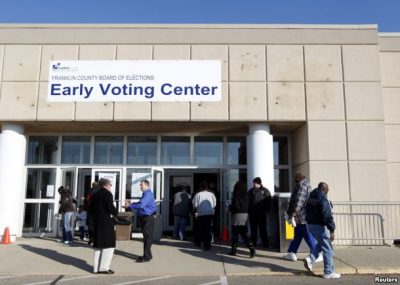22nd October, 2016

New data from the Pew Research Center indicated that more than 4 million ballots had been cast by Saturday, and that before November 8 arrives, the advance voting total may well swell beyond 50 million, the most ever. That would be a significant proportion of the overall voter turnout, which probably will be at least 130 million ballots.
In 1996, about 10 percent of voters used alternative voting methods, either voting early or casting absentee ballots, according to U.S. census data. Four years ago, in the last presidential election, that proportion was nearly 33 percent.
And in some states, that percentage is much higher. More than half of ballots cast in the 2012 election in Nevada, Arizona, Texas, North Carolina, Montana, New Mexico and Tennessee were either early or absentee, according to Pew researchers.
Unlike most democracies, the U.S. does not have a centrally administered electoral system, meaning each state — and in some cases, even each county — determines how and when residents can vote. Rules and dates differ by state, but more than half of the 50 states allow some form of early voting, either in person or by mail-in ballots.
Oregon, Washington, and Colorado conduct their elections entirely through posted ballots.
California and the District of Columbia allow their residents to vote early either in person or through the mail, while others allow only one method.
Absentee voting began more than a century ago, during the American Civil War, as a way soldiers in combat could send their ballots back home. By the mid-20th century, most states had adopted some form of absentee voting, although it was restricted, usually requiring specific evidence that a voter was unable to cast a ballot in person on Election Day.
California, Oregon, and Washington were among the first states in the 1970s and 1980s to allow voters to cast absentee ballots without providing a specific reason, such as out-of-town travel on Election Day, temporary residence abroad, physical infirmity or job requirements. Today, 27 states and the District of Columbia allow “no excuse” absentee voting for their residents.
Regardless of how or where they vote, more Americans are acting early on their electoral choices. This has begun to alter political parties’ traditional campaign exhortations for everyone to go to the polls on Election Day.
Apart from the convenience early voting offers to most people, the trend can either help or hurt candidates whose campaigns peak just before Election Day. Rhetoric during the last weeks of the campaign this year will have little or no effect on large numbers of voters.
Though the early votes won’t be counted until on or after November 8, exit polling and demographic analysis of who voted early (such as how many Republicans vs. Democrats did so, or how many men compared with how many women, the number of ballots by whites vs. minorities, etc.) can give a better idea than many public opinion polls about candidates’ chances of winning. That depends, however, on how much information each state divulges about its early voters.
Compared with the last presidential vote in 2012, more Democrats are requesting absentee ballots or voting early in critical swing states this year. In North Carolina and Florida, in particular, the number of Democrats voting early is much higher than it was in 2012, although Republicans still are the most frequent applicants for early ballots.
Women are also disproportionately voting early, particularly in these two states, though analysts said it was too early to tell just how much this would benefit Democratic nominee Hillary Clinton, who is generally thought to have greater support from women than Republican Donald Trump.
Voice of America (VOA)


